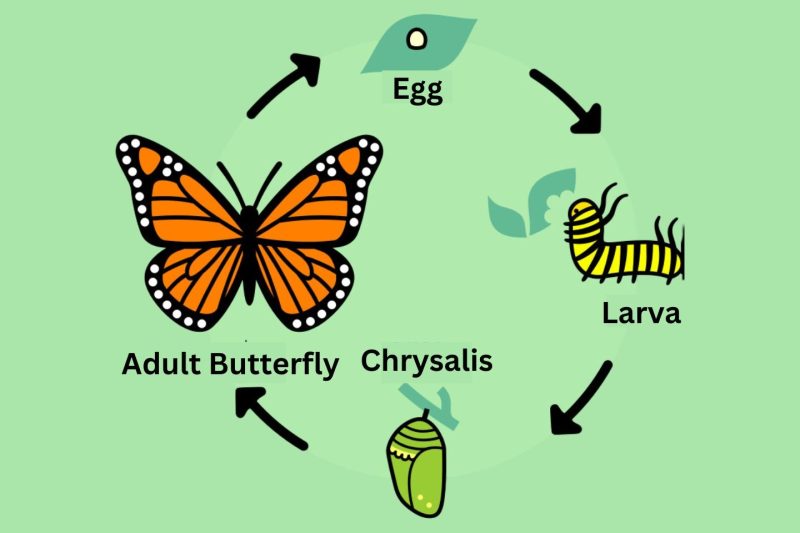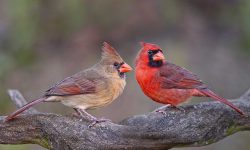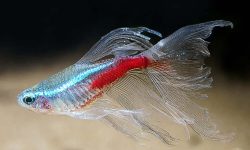The transformation of a butterfly is one of nature’s most remarkable processes—a story of profound change, survival, and beauty. Known as complete metamorphosis, the butterfly life cycle unfolds in four distinct stages: egg, larva (caterpillar), pupa (chrysalis), and adult butterfly. Each stage plays a critical role, shaped by biology, environment, and evolutionary pressures.
This article explores each step in-depth, revealing not just what happens, but how and why it happens.

The Four Stages of a Butterfly’s Life
Overview of Metamorphosis
Butterflies undergo holometabolism, or complete metamorphosis—a biological process where the organism changes form entirely at different life stages. This strategy allows larvae and adults to occupy different ecological niches, reducing competition for food and space.
The cycle includes:
-
Egg – the origin of life
-
Larva (caterpillar) – the feeding and growth machine
-
Pupa (chrysalis) – the stage of transformation
-
Adult butterfly – the reproductive and dispersal phase
Stage 1: The Egg – Beginning of the Cycle
Structure and Composition
Butterfly eggs are tiny—often less than 1 mm—and usually laid on or near host plants. Their surfaces can be ribbed, domed, or sculpted depending on species. The egg shell, called the chorion, is lined with a wax layer to prevent desiccation.
Inside is a developing embryo, surrounded by yolk, which provides nutrition until hatching.
Egg Laying Behavior
Female butterflies are highly selective about where they deposit their eggs. They rely on chemoreceptors in their feet to “taste” the plant surface and determine suitability. Most species lay eggs on specific host plants critical for larval survival.
The number of eggs laid can range from a few dozen to hundreds, depending on species and environmental conditions.
Duration
Egg development time varies with temperature, humidity, and species—from 3 to 14 days in many common butterflies. Warmer temperatures generally accelerate development.
Stage 2: The Larva – The Eating Machine
Anatomy and Physiology
The larva, or caterpillar, is a segmented, worm-like organism with:
-
Six true legs and additional prolegs for gripping
-
Powerful mandibles for chewing plant tissue
-
A simple gut for rapid digestion
-
Spinnerets for producing silk
Caterpillars also have ocelli (simple eyes) and antennae, though their vision is limited.
Feeding Behavior
This stage is dedicated almost entirely to eating and growing. Caterpillars consume host plant leaves, flowers, or stems. Their appetite is enormous—they may increase their body weight thousands of times in just a few days.
Many exhibit specialist feeding—limited to one plant species (monophagous)—while others are generalists.
Molting and Instars
As caterpillars grow, their outer skin (cuticle) becomes too tight and is shed in a process called molting. Each period between molts is called an instar, typically ranging from 4 to 6 in most species.
Defense Mechanisms
Though soft-bodied, caterpillars employ various defenses:
-
Camouflage to blend into foliage
-
Toxic or distasteful compounds from host plants (e.g., monarchs and milkweed)
-
Eye spots or mimicry to deter predators
Stage 3: The Pupa – Metamorphosis Begins
Formation of the Chrysalis
Once fully grown, the caterpillar stops feeding and searches for a safe, sheltered location to pupate. Using silk, it attaches itself to a surface and sheds its final larval skin to reveal the chrysalis (pupa).
Internal Transformation
Inside the pupa, the caterpillar undergoes one of biology’s most complex transformations:
-
Larval tissues are broken down
-
Imaginal discs—groups of undifferentiated cells—develop into wings, legs, eyes, and adult organs
-
Enzymatic and hormonal changes drive the restructuring of nearly every body system
This process is regulated by hormones like ecdysone and juvenile hormone, which control tissue remodeling.
Duration and Vulnerability
Pupal duration can last from a few days to several months, depending on species and climate. Many butterflies overwinter in this stage.
Despite its hardened exterior, the chrysalis is vulnerable to predators like birds, wasps, ants, and parasitic flies.
Stage 4: The Adult Butterfly – Flight and Reproduction
Anatomy and Coloration
The adult butterfly emerges with:
-
Two pairs of scale-covered wings
-
Large compound eyes for color and motion detection
-
A long, coiled proboscis for sipping nectar
-
Antennae for smell and orientation
-
Reproductive organs (functional shortly after emergence)
Wing coloration is produced by microscopic scales that reflect and refract light or contain pigments like melanin and carotenoids.
The First Flight
Once emerged, the butterfly must pump hemolymph into its wings to expand and dry them—a process taking up to several hours. Only then can it fly in search of nectar and mates.
Feeding
Adult butterflies feed primarily on nectar, though some also sip:
-
Rotting fruit
-
Tree sap
-
Pollen (e.g., in Heliconius butterflies)
-
Mineral-rich mud (puddling)
Nectar is rich in sugars, providing energy for flight and reproduction.
Mating Behavior
Butterflies engage in courtship displays, chemical signaling (pheromones), and visual cues. Mating can last from minutes to hours, and females may mate multiple times in some species.
Lifespan
Adult butterflies typically live from a few days to several weeks, although some migratory or overwintering species (e.g., monarchs) may live several months.
Environmental Influences on the Butterfly Life Cycle
Temperature and Seasonality
The speed of development at each stage is heavily influenced by temperature. Warmer conditions accelerate metabolism and growth, while cooler temperatures slow it down.
Some species undergo diapause—a hormonally regulated pause in development—allowing them to survive cold or dry seasons.
Photoperiod and Hormonal Control
Butterflies use daylength (photoperiod) to time critical transitions. Short days may trigger diapause or longer larval stages, while longer days accelerate development and reproduction.
Hormonal feedback loops ensure that metamorphosis proceeds only when nutritional and environmental conditions are favorable.
Specialized Life Cycle Strategies
Migration and Reproductive Delay
Species like the Monarch butterfly (Danaus plexippus) have evolved migratory strategies. The late-summer generation delays reproduction and migrates thousands of miles, entering diapause until spring conditions return.
This strategy involves genetic and physiological programming distinct from earlier generations.
Host Plant Co-Evolution
Many butterflies have co-evolved with specific host plants. For instance, pipevine swallowtails rely on Aristolochia species, whose toxic compounds become part of the butterfly’s chemical defense.
These tight associations can affect:
-
Oviposition preference
-
Larval survival
-
Pupation behavior
Threats to the Butterfly Life Cycle
Habitat Loss
Urbanization and agriculture often eliminate native host plants, disrupting egg laying and larval feeding. Even small changes—like mowing too early or removing milkweed—can collapse local butterfly populations.
Pesticides and Pollution
Herbicides kill essential nectar and larval plants, while insecticides may directly poison caterpillars or adults. Light pollution can disrupt navigation and oviposition cycles.
Climate Change
Global warming alters flowering times, affects host plant ranges, and disturbs synchrony between butterfly development and resource availability, especially in alpine and temperate species.
Supporting Butterfly Life Cycles
In Gardens and Urban Areas
-
Plant native nectar and host plants
-
Avoid chemical pesticides and herbicides
-
Create sheltered spaces for pupation
-
Allow leaf litter and wild corners to remain undisturbed
-
Provide moist soil or puddling spots for minerals
In Agriculture and Policy
-
Maintain wildflower borders
-
Promote integrated pest management
-
Support conservation corridors and native plant restoration
-
Participate in citizen science programs that monitor butterfly populations
Conclusion
The life cycle of a butterfly—from egg to winged wonder—is not just a biological marvel but a narrative of adaptation, resilience, and ecological interdependence. Every stage of development is a finely tuned response to environmental pressures, nutritional needs, and survival strategies.
Understanding this complex process helps us not only admire butterflies more deeply, but also protect the landscapes and plant life that sustain them. In a changing world, fostering healthy butterfly populations means preserving more than beauty—it means protecting the ecosystems that keep us all alive.






